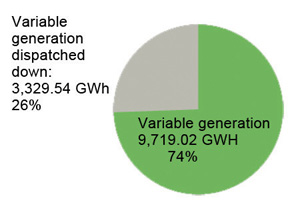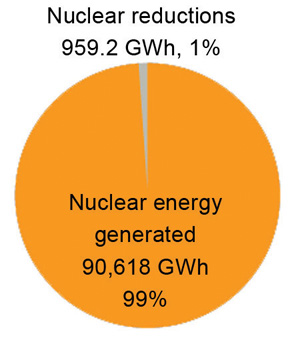A mild and wet summer led to lower peak days and reduced total demand for electricity in Ontario last year, the IESO said in a recent release of its electricity data for 2017.
Total energy demand in 2017 was 132.1 terawatt-hours, a 4.9 TWh or 3.6 percent reduction from demand levels in 2016. The highest demand peak of the year was recorded at 21,786 megawatts on September 25 during a prolonged period of unseasonably high temperatures.
Nuclear power made up 35 percent of installed capacity on the transmission system, and represented 63 percent of the energy produced in 2017. Corresponding to lower overall and peak demand, gas generation use went down in 2017 to four percent.
 In 2017, the total amount of wind and solar energy that was dispatched down was 3,329.5 GWh. Variable generation dispatch allows the system operator to harness the flexibility of wind and solar to help balance the system.
In 2017, the total amount of wind and solar energy that was dispatched down was 3,329.5 GWh. Variable generation dispatch allows the system operator to harness the flexibility of wind and solar to help balance the system.
2017 Transmission-Connected Generator Output
|
|
Nuclear |
Hydro |
Gas/Oil |
Wind |
Biofuel |
Solar |
|
2017 (TWh) |
90.6 |
37.7 |
5.9 |
9.2 |
0.4 |
0.5 |
|
2017 (% of total) |
63% |
26% |
4% |
6% |
<1% |
<1% |
|
2016 (TWh) |
91.7 |
35.7 |
12.7 |
9.3 |
0.49 |
0.46** |
|
2016 (% of total) |
61% |
24% |
9% |
6% |
<1% |
<1% |
|
2015 (TWh) |
92.3 |
36.3 |
15.4 |
9.0 |
0.45 |
0.25** |
|
2015 (% of total) |
60% |
24% |
10% |
6% |
<1% |
<1% |
At the end of 2017, there were more than 3,880 MW of contracted embedded generation within local distribution systems, a 25 percent increase since last year.
The weighted wholesale price of electricity – the Hourly Ontario Energy Price (HOEP) – for 2017 was 1.58 cents/kilowatt-hour (kWh). The estimated 2017 Global Adjustment (GA) Class B rate as of January 15, 2018, was 9.97 cents/kWh. The total cost of power for Class B consumers, representing the combined effect of the HOEP and the GA, was 11.55 cents/kWh.
Ontario continued to be a net exporter, importing 6,627 GWh and exporting 19,098 GWh in 2017. This represented an 11 percent decrease in net export volumes over 2016.
At the halfway mark for the Conservation First Framework, the province is on track to meet its targeted energy savings of 7 TWh target for the CFF and 1.7 TWh for the Industrial Accelerator Program by 2020. Preliminary results for 2017 indicate nearly four terawatt-hours (TWh) of net energy was saved, attributable to programs delivered by local distribution companies and the IESO since 2015.
 Nuclear manoeuvering capability offered by Bruce Power supports system reliability by reducing the output of nuclear units by approximately 300 MW each. This capability provides valuable flexibility to the system during period of low demand where surplus baseload generation (SBG) exists; they also help the IESO prevent nuclear shutdowns. According to preliminary data, there were 511 nuclear manoeuvers in 2017, representing a total of 959.2 GWh, and three nuclear shutdowns to help manage SBG.
Nuclear manoeuvering capability offered by Bruce Power supports system reliability by reducing the output of nuclear units by approximately 300 MW each. This capability provides valuable flexibility to the system during period of low demand where surplus baseload generation (SBG) exists; they also help the IESO prevent nuclear shutdowns. According to preliminary data, there were 511 nuclear manoeuvers in 2017, representing a total of 959.2 GWh, and three nuclear shutdowns to help manage SBG.
Looking ahead, Ontario’s power system is “well-positioned to maintain reliability in 2018 and into the future putting the IESO in a good position to continue to pursue enhancements to Ontario’s electricity market through the Market Renewal project,” the IESO concludes.
